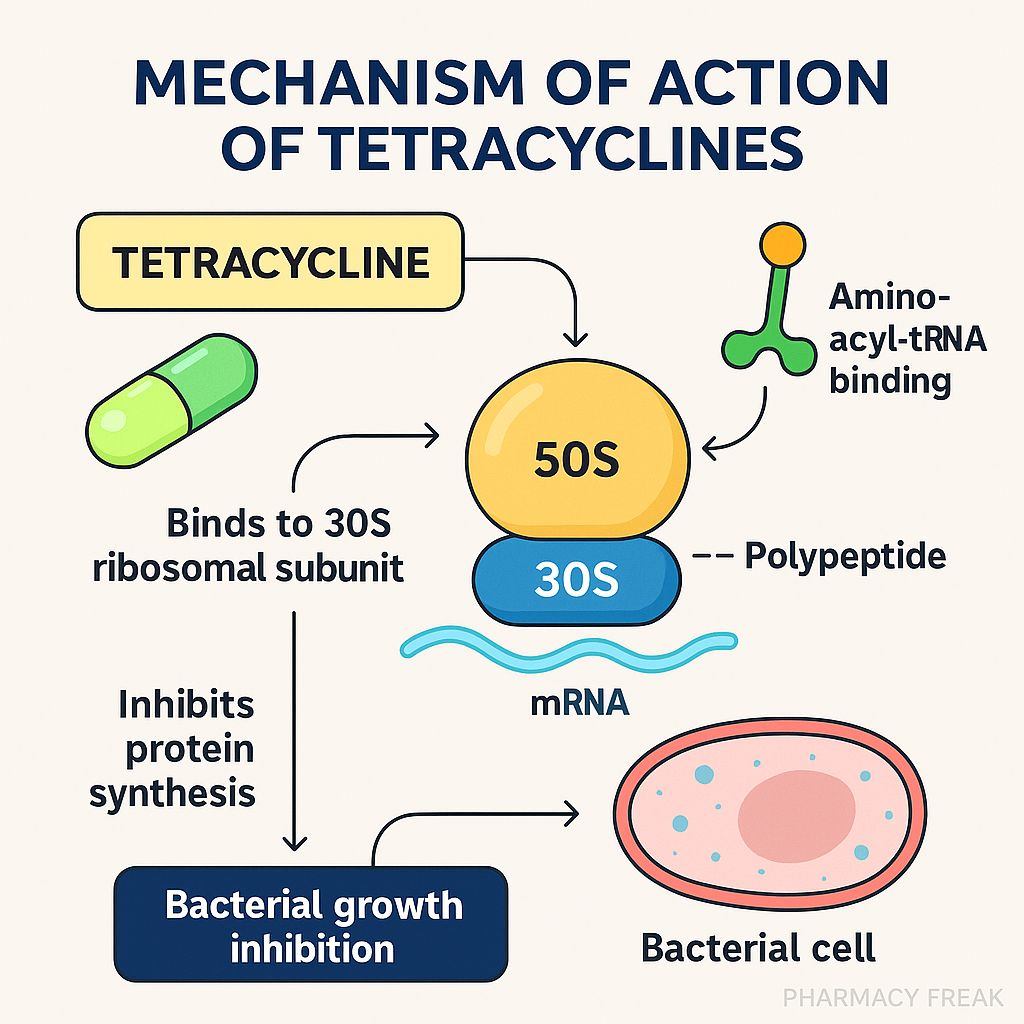Table of Contents
Introduction
Tetracyclines are a class of broad-spectrum bacteriostatic antibiotics that inhibit bacterial protein synthesis. Common examples include tetracycline, doxycycline, minocycline, and demeclocycline. They are effective against a wide variety of Gram-positive, Gram-negative, and atypical organisms, including Rickettsia, Chlamydia, Mycoplasma, and Borrelia.
Due to their broad usage and distinct mechanism, tetracyclines are high-yield topics for USMLE, NCLEX, GPAT, and NEET-PG, especially in infectious disease and microbiology questions.
Stepwise Mechanism of Action of Tetracyclines
- Entry into the bacterial cell
Tetracyclines enter Gram-negative bacteria via porin channels and actively cross the inner membrane using energy-dependent transport systems. - Binding to the 30S ribosomal subunit
They bind reversibly to the 30S subunit of the bacterial ribosome at the A-site. - Blocking aminoacyl-tRNA attachment
Tetracyclines prevent the binding of aminoacyl-tRNA to the ribosomal acceptor site, halting elongation of the peptide chain. - Inhibition of bacterial protein synthesis
By stopping tRNA binding, they block translation, thereby inhibiting bacterial growth. - Selective toxicity
Mammalian cells lack the tetracycline transport system, so their ribosomes are not affected.
Pharmacokinetic Parameters of Tetracyclines (e.g., Doxycycline)
| Parameter | Value |
|---|---|
| Bioavailability | 90–100% (doxycycline) |
| Half-life | 12–24 hours |
| Protein binding | ~90% |
| Metabolism | Minimal hepatic metabolism |
| Excretion | Fecal (doxycycline), renal (others) |
| CNS penetration | Moderate |
Clinical Uses of Tetracyclines
- Rickettsial infections (e.g., Rocky Mountain spotted fever)
- Chlamydia infections (STIs, PID)
- Mycoplasma pneumoniae (atypical pneumonia)
- Lyme disease (Borrelia burgdorferi)
- Brucellosis and plague
- Acne vulgaris (oral doxycycline)
- Malaria prophylaxis
- Helicobacter pylori (in combination therapy)
Adverse Effects of Tetracyclines
- Photosensitivity – sunburn-like reaction
- GI irritation – nausea, vomiting, esophagitis
- Tooth discoloration and enamel hypoplasia (in children)
- Hepatotoxicity (rare but serious in pregnancy)
- Fanconi syndrome (expired tetracycline use)
- Superinfections – C. difficile, Candida
- Vertigo (minocycline)
Comparative Analysis: Tetracycline vs Doxycycline
| Feature | Tetracycline | Doxycycline |
|---|---|---|
| Bioavailability | ~60–70% | ~90–100% |
| Excretion | Renal | Fecal |
| Half-life | Shorter | Longer |
| Use in renal failure | Avoid | Safe |
| Photosensitivity | Moderate | High |
Practice MCQs
Q1. Tetracyclines inhibit protein synthesis by binding to:
a. 50S subunit
b. 30S subunit ✅
c. DNA gyrase
d. RNA polymerase
Q2. The primary action of tetracyclines is:
a. Prevent peptide bond formation
b. Block translocation
c. Block tRNA binding ✅
d. Cause mRNA misreading
Q3. Tetracyclines are contraindicated in:
a. Adults with acne
b. Pregnant women ✅
c. Diabetic patients
d. Patients with hypertension
Q4. Which side effect is seen with expired tetracyclines?
a. Nephrotoxicity
b. Fanconi syndrome ✅
c. QT prolongation
d. Photosensitivity
Q5. Which organism is treated with doxycycline?
a. Plasmodium falciparum
b. Mycoplasma pneumoniae ✅
c. MRSA
d. Pseudomonas
Q6. Tooth discoloration in children is due to:
a. Protein synthesis inhibition
b. Iron chelation
c. Calcium binding by tetracycline ✅
d. Enzyme inhibition
Q7. Doxycycline is preferred in renal failure because:
a. It is hepatically cleared
b. It is fecally excreted ✅
c. It is less toxic
d. It inhibits CYP450
Q8. Tetracyclines should not be taken with:
a. Iron
b. Calcium
c. Antacids
d. All of the above ✅
Q9. Minocycline can cause:
a. Ototoxicity
b. Hepatotoxicity
c. Vertigo ✅
d. Hypoglycemia
Q10. Which infection is not treated with tetracyclines?
a. Brucellosis
b. Rickettsia
c. Tuberculosis ✅
d. Lyme disease
FAQs
Q1: Are tetracyclines safe in pregnancy?
No, they are contraindicated due to fetal tooth and bone toxicity.
Q2: Why avoid dairy with tetracyclines?
Calcium binds the drug and reduces oral absorption.
Q3: Can doxycycline be used in renal failure?
Yes, because it is fecally excreted, unlike other tetracyclines.
Q4: Do tetracyclines cross the placenta?
Yes, and they can affect fetal bone and teeth development.
Q5: What should patients avoid during therapy?
Avoid sun exposure, iron supplements, and antacids.
References
- KD Tripathi – Essentials of Medical Pharmacology
- Goodman & Gilman – The Pharmacological Basis of Therapeutics
- Sparsh Gupta – Review of Pharmacology
- NCBI: https://www.ncbi.nlm.nih.gov/books/NBK539844/

I am pursuing MBA in pharmaceutical management from NIPER Hyderabad with a strong academic record and proven success in national-level pharmacy entrance exams. I secured AIR 61 in NIPER 2024 (MS/M.Pharm) and AIR 27 in NIPER MBA, along with AIR 147 in GPAT 2024 and AIR 907 in GPAT 2023. I also achieved AIR 6 in AIIMS CRE-2025 for Drug Store Keeper and was selected as a Pharmacist (AIR 61) for ESIC. Additionally, I was the Runner-Up in Round 2 of the EY Case Study Competition.
At PharmacyFreak.com, I aim to guide future pharmacists through expert content, exam strategies, and insightful resources based on real experience and academic excellence.
Mail- harsh@pharmacyfreak.com
